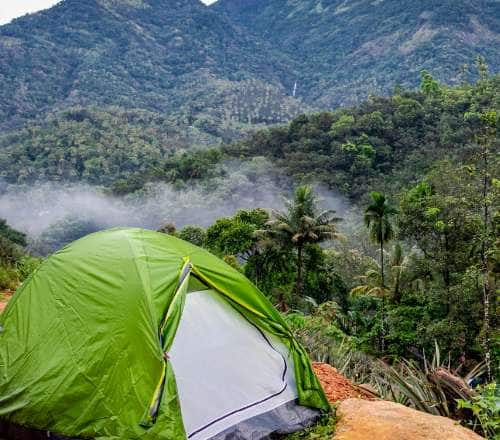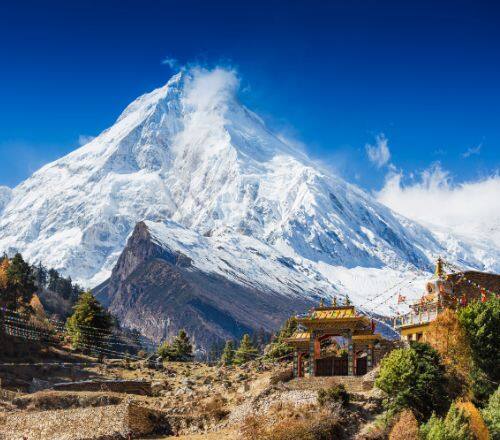Stay logged in to proceed with bookings, orders and offers.
On changing the terminal, you will loose items in your cart. Are you sure you want to change your terminal?
Embark on an adventure of a lifetime in the remote village of Willong Khullen, known for its unique monoliths on the Manipur-Nagaland border.
On my first trip to the beautiful Northeastern state of Manipur, I decided to travel solo! Well, not completely — I had my cabbie, Mr Khaba, a delightful person who regaled me with intriguing stories that kept my mind off the bumpy roads. We were on National Highway 129A, heading for the Nagaland border. Instead of visiting the tourist hubs, I decided to take the road less travelled to the border village of Willong Khullen. I'd read that the village is known for its cluster of bizarre monoliths, and I was curious to know more about them.
Read More
Read Less
As we bumped along the potholed road, the views only got better. However, the numerous army checkposts and random passenger checks along the way were a reminder of Manipur's troubled history.
"They check your fingertips," said Khaba. "If you have callused fingertips, maybe (they think) you're a terrorist (who is) used to pressing a gun's trigger!"
At one of the checkpoints, some soldiers asked me to get out of the car and checked my credentials. Although they let us go eventually, the event left me feeling a little shaken.However, the landscape had a calming effect on me. The clouds hung like a veil on the lush green mountains. The Garo-Khasi Hills seemed to blend with the valley below, with a small river snaking through. It all looked picture-perfect!
As we approached the village of Willong Khullen, I caught my first glimpse of the hamlet – a colourful settlement perched on the edge of a cliff. It looked beautiful amidst the verdant surroundings. A small diversion of just a few hundred metres from the highway took us to the entrance to the village.
Before we reached the village, I saw rows of vertical stone slabs in myriad shapes and sizes standing right next to the highway. These stone monoliths were perched neatly on elevated land, their bases covered with thick undergrowth. It seemed like someone had placed these vertical stones with great care in the ground! Surrounded by barbed wire, the monoliths looked like sentinels guarding this obscure settlement.
What is interesting is that no one knows who built the monoliths, or why!
I thought of similar structures in England, France, and Western Australia and was curious to know what the villagers thought. Khaba helped me speak to a few of them. "These are our tribe's warriors! Our ancestors built these slabs in their memory," shared Mr Lechung, a village elder. "They are guardian angels who always protect us from the unrest!"
Other villagers had a different view of the monoliths. Many considered them sacred spirits who come alive at night. "No one goes near the slabs after dark. It's forbidden," said Gompa, a young resident. Another said that it is impossible to count the monoliths as the spirits forbid it! It is actually confusing to count them as they stand in irregular lines. I didn’t even try. Why anger the spirits?
While I was taking pictures of the monoliths, I met Mr Ruman. He was a middle-aged man dressed in a business suit. He told me about his plan to build a small hotel here, with rooms looking out over the monoliths and surrounding mountains. I wished him luck but I wondered about his prospects in such a remote place.
Willong Khullen is situated more than 6,500 ft above sea level, atop a green mountain and surrounded by deep gorges. I was the only tourist here. The place was uncannily quiet. People were around, but no one spoke. The only sounds were of the rustling leaves, chirping birds, and occasional gusts of wind.
As I made my way through the village, I admired the neatly stacked houses on either side of the solitary road. This road culminated at a green-painted church at the edge of the cliff. The small village square has a community centre, and its steps serve as a common area for socialising.
Many of the locals that I interacted with were curious about my background. What was I doing in their village? Where was I from?
One friendly villager, Mr Gumiyang, even invited me for a meal of pork and rice. Although I politely declined, he requested me to sit on his porch for a while. We had a nice conversation with Khaba acting as our interpreter.
First, Mr Gumiyang was very interested in my camera and enquired about it. Then he told me about himself. He boasted that he was a great cook, subtly referring to the earlier lunch invite. He also talked of his son who studies in Imphal. And of his wife, who helps him grow rice in the field. Most villagers in Willong Khullen grow rice. Both men and women share the burden of work, which is typical of Northeast Indian cultures.
At the edge of the cliff stands a statue of Lord Jesus, overlooking the village with spread arms. This small yet beautiful statue is perched above Willong Baptist Church, which presents the perfect frame for photography.
Although the village's population is a mix of Christians, Hindus, and Muslims, they are descendants of the Maram Naga tribe. This tribe was known to preserve its age-old traditions and rituals. But with the introduction of Christianity, the tribal customs and ethos are fading, especially among the youth.
"We are trying to keep our traditions alive," shared Mr Baz, a village elder. "We make sure to celebrate our ancient festivals of Ponghi (a week-long paddy festival), Mankang (a festival for newly married couples), and Kanghi (a seven-day youth festival where naked wrestlers fight to ward off evil). We involve everyone in the village and even invite those who are away for education or work. However, the numbers decline each year."
The community centre is located in the heart of the village. It features a façade and the design of mithun (bison) horns on the roof, which is typical of Naga architecture. Some villagers, including women and children, were sitting on the centre's front steps, chatting animatedly.
Mr Lechung lamented, "This used to be a vibrant centre with all types of social activities: cultural programs, customary dances, and traditional practices. It isn’t the same anymore. The centre now remains shut most of the time. The sense of belonging is lost."
Before the community centre lies a huge vertical slab, with the names of the village founders. They were the village's first inhabitants. Although the slab was erected only in 2016, the year the village was established is unknown. The slab reminded me of the monoliths standing guard at the village entrance.
Getting there
There are daily flights from Kolkata to Imphal. The nearest town to Willing Khullen is Senapati, which is just over a two-hour drive away. From Imphal, it will take at least five hours to reach the village as the roads are not in great condition. Cabs usually charge INR 4,500 for a round trip.
Where to stay
A member of the Radisson group, Classic Grande is a top-of-the-range hotel that offers the most luxurious stay in Manipur. Rooms start from INR 4,500. Alternatively, The Classic Hotel, which was one of the first star hotels to open in Manipur, has comfortable double rooms at a tariff of INR 2,000 onwards.
Where to eat
If you are looking for an authentic Manipuri plate, then Luxmi Kitchen is the place for you. It is located near Mother’s Market and is an absolute value for money. Rita Café is a cosy eatery that is part of The Classic Hotel and has beautiful interiors. It is a great place to listen to live bands playing Manipuri music.
The road to Willong Khullen may have been tough, but the warm, friendly locals make up for it. While communication can be an issue, I was fortunate to have had Khaba as a translator during my visit. The views in Willong Khullen are mesmerising and different from the typical mountain scenes. As there are no "points to see" as such, I explored every inch of the village to absorb its essence. I couldn't seem to get over the monoliths and their unknown creators. I spent wondrous days doing nothing. I could just be.





The Adani One expressly disclaims all liability, direct and indirect, in respect to actions taken or not taken based on any or all the contents of this Blog. The Blog is an opinion of the contributor based on the collation of data from various sources and is provided only for information purpose. Adani One does not canvass, advertise, solicit, invite or induct for any product, merchandise, information, brand or any other materials mentioned in the Blog, nor does it obtain any monetary benefit from the same. Reader is advised to read and apply his/her intellect and discretion in this regard. Any Intellectual Property mentioned in this blog belongs to the rightful owner. We do not intent to claim any interest over the same.